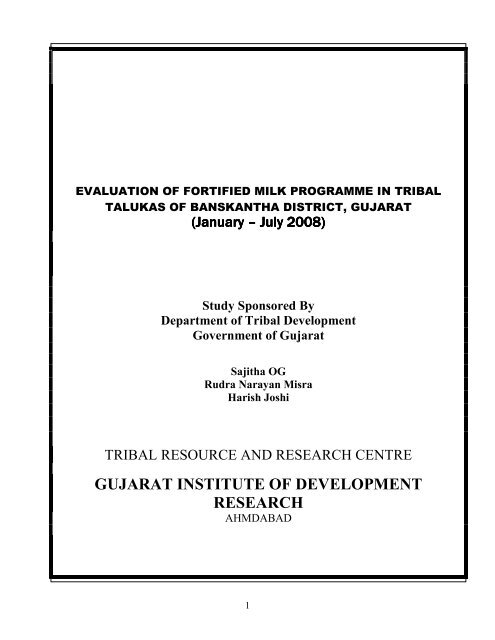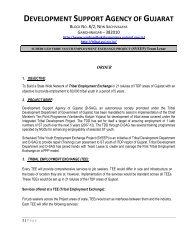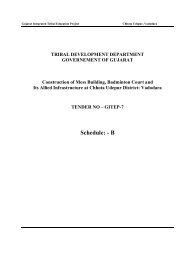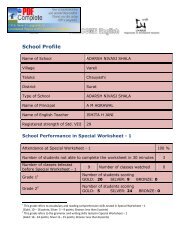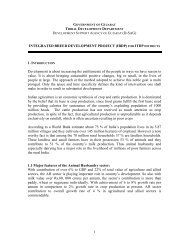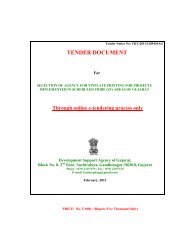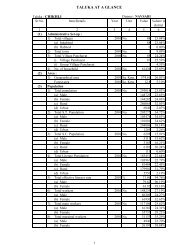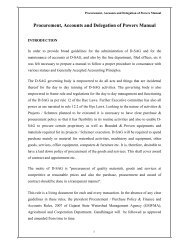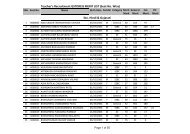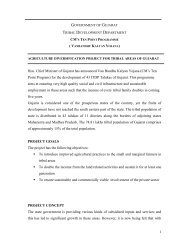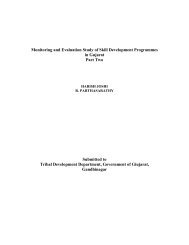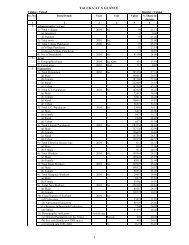Fortified Milk Programme - Vanbandhu Kalyan Yojana - Government ...
Fortified Milk Programme - Vanbandhu Kalyan Yojana - Government ...
Fortified Milk Programme - Vanbandhu Kalyan Yojana - Government ...
You also want an ePaper? Increase the reach of your titles
YUMPU automatically turns print PDFs into web optimized ePapers that Google loves.
Draft For Comment<br />
EVALUATION OF FORTIFIED MILK PROGRAMME IN TRIBAL TALUKAS<br />
OF BANSKANTHA DISTRICT, GUJARAT<br />
ABSTRACT<br />
Tribals are one of the disadvantaged sections of the society in terms of their social, economic and human<br />
development related indicators through out the country, Gujarat is no exception. To improve their quality<br />
of life several schemes have been devised and implemented. One of such programme is ‘Dudh Sanjevani<br />
<strong>Yojana</strong>’ implemented by Tribal welfare department of Gujarat. The programme started in February 2007,<br />
aims to provide 200 ml. of milk , to children of first to fifth standard, in all government run schools and<br />
ashramasalas, in two tribal dominated talukas of Banaskantha district, namely Dantha and Amirgadh. The<br />
major objectives TALUKAS of the scheme OF are BANSKANTHA to remove vitamin-A deficiency DISTRICT, of tribal children GUJARAT<br />
and improve their<br />
nutritional status and attracting them to the school system to improve their educational status. Both health<br />
and education are crucial input to (January any human development – July 2008)<br />
related outcome. An evaluation of the<br />
programme was done by Gujarat Institute of Development Research on behalf of Tribal Development<br />
Department of <strong>Government</strong> of Gujarat, in order to study the efficiency of programme in terms of it’s<br />
implementation, coverage and possible shortcomings, to strengthen the programme and increase the<br />
coverage to other regions. The evaluation is done in selected schools of these two talukas. A total of 36<br />
schools, 36 Midday meal workers, more than 2500 children, 8 route contractors, officials of different<br />
agencies associated with the implementation and several personal interviews constitute the evaluation<br />
methodology. The results show high attendance rate in schools of Dantha and Amirgadh where the FF milk<br />
had been provided. It is identified that the target of the programme was adequately met, as the attendance<br />
rate in schools (for a fifteen day) was Study observed Sponsored as 80 percent. The By programme is seemed capable of<br />
bringing positive social change Department in the society. of The Tribal younger children Development<br />
are happily taking the milk without<br />
any gender constraint. But from the non drinking elder girl children it is identified that discrimination<br />
exists in these areas in providing nutritious <strong>Government</strong> food like milk to of female Gujarat children. And such discrimination will<br />
not root in the young minds of both sexes due to this kind of programme. If the management and<br />
distribution at school is overlooked by teacher or principal there the programme faced little problems and<br />
hence the study suggests constituting a committee at school level to overlook the activities at school level.<br />
The MDM workers at delivery centres are the Sajitha unhappy ones, OG who spend considerable time without any<br />
additional remuneration to ensure other Rudra designated Narayan schools under Misra their centre gets the milk. There is<br />
difficulty in handling of newly provided insulated milk crates, especially for MDM workers who have to<br />
Harish Joshi<br />
carry them on head, cycles or hired vehicles to inapproachable and far away schools. Dairy has to devise<br />
methods to make the crates user friendly and ensure that crates are properly sanitized at the factory. Like<br />
midday meal, the school teachers should be held accountable for the implementation of the programme. At<br />
Banaskantha dairy, it is found that they have to improve the communication with school teachers and<br />
MDM workers to dispel some of the notions about the quality of milk. The distribution of transportation<br />
charge should be regular for MDM workers. In nutshell this landmark programme will go a long way to<br />
improve the TRIBAL health status RESOURCE of the Tribal children AND of Banaskantha, RESEARCH provided all the CENTRE<br />
stakeholders in the<br />
EVALUATION OF FORTIFIED MILK PROGRAMME IN TRIBAL<br />
programme work as cohesive unit.<br />
GUJARAT INSTITUTE OF DEVELOPMENT<br />
RESEARCH<br />
AHMDABAD<br />
1
EVALUATION OF FORTIFIED MILK PROGRAMME IN TRIBAL TALUKAS<br />
OF BANSKANTHA DISTRICT, GUJARAT<br />
1.1 Background<br />
Banaskantha district is in the northeast of Gujarat state with a population of 25 Lakhs as<br />
per 2001 Census. Even though only 8.2 percent of the district population is scheduled<br />
tribe, 71 percent of it is concentrated in two talukas namely Dantha and Amirgadh. In<br />
both the talukas, 53 percent of total population is scheduled tribe. The basic health<br />
indicators for the district are shown in Table 1.1. The indicators of health and mortality in<br />
Banaskantha district (Table 1.1) stipulate high need of intervention programmes to<br />
improve the health status of the population. The infant and under five mortality in<br />
Banaskantha are very high, 74.80 and 88.96 respectively. The percentage of children<br />
receiving full vaccination was only 31.0 percent even though the state has a target of cent<br />
percentage immunization by 2010 (GOG, 2002). Vitamin A supplementation programme<br />
has been in operation since 1970 in the country, yet the percentage of children received<br />
Vitamin A is very low in Banaskantha district. The percentage of women squeezing first<br />
milk from breast was also noted to be very high in the district.<br />
Table 1.1. Basic Health Indicators, Banaskantha District, Gujarat 2002-04<br />
Indicator<br />
Value<br />
Total fertility rate 2.90<br />
Infant mortality 74.80<br />
Under five mortality 88.96<br />
Crude death rate CDR 5.65<br />
Prevalence - complete blindness $ 286<br />
Prevalence - partial blindness $ 4105<br />
% Squeezed first milk form breast * 61.7<br />
% of children provided Vitamin A Vaccine** 30.3<br />
% of children received full vaccination 31.0<br />
$ Per Lakh Population<br />
* with youngest child born during three year prior to survey<br />
** Includes only last and last but one living child born within three year prior to the<br />
survey and 12-35 months at the time of survey.<br />
Source: RCH Survey, 2002-04.<br />
2
Tribal Development Department of the state government started intervention to improve<br />
the health status of children in two tribal dominated talukas of Banaskantha District<br />
namely Dantha and Amirgadh by providing fortified milk to all schools from class one to<br />
five in <strong>Government</strong> schools and Ashramsals. It is known as ‘Dudh Sanjivani <strong>Yojana</strong>’<br />
and was launched on 9 th February, 2007. Under this scheme it is supposed to provide<br />
200ml of fortified milk to more than 50,000 students of 299 primary schools and 26<br />
Ashram schools of these two talukas during all school days. Contents of milk are Fat: 3<br />
gm / Total Carbohydrate: 24 gm / Protein: 7 gm / Vitamin A 500 UL equivalent to 150<br />
meg / Vitamin D 40 UL equivalent to 1 meg / Flavour: Ilaichi or Rose. This scheme<br />
comes under the Mid Day Meal (MDM) <strong>Programme</strong>, a programme to provide mid day<br />
meal to the primary school children in the country. Under this scheme, cultural diversity<br />
and food habits of Indian population are respected in such a way that the components in<br />
food vary from one state to another depending upon the food habit of the concerned<br />
society.<br />
1.2 An Overview of the programme:<br />
The organisational network is shown in Flow chart 1 below. <strong>Milk</strong> crates are transported<br />
from Banas dairy to the two distributing centres one each in Dantha and Amirgadh<br />
talukas, in insulated van during early morning. From these two distribution centres route<br />
contractors transport the milk crates to some schools on their routes (here after called as<br />
delivery centres). In all, there are nine routes fixed for transportation of milk. Five of<br />
them are operate from Dantha and the rest from Amirgadh. On each of the routes there<br />
are certain villages where milk crates are delivered and from there MDM organizers /<br />
teachers collect milk for their schools. Time of delivery of milk is noted at each of the<br />
delivery centres in a prescribed form. At the same time, demand for the next day has to<br />
be submitted. Later all figures of demand from each of the routes will be collected and<br />
sent to the distributing centres. From there information is conveyed to the vigilance office<br />
over phone at Palanpur and then the latter conveys the demand of number of milk<br />
pouches for the next day to the dairy and accordingly arrangements are made for the next<br />
day’s supply.<br />
3
Flow Chart 1<br />
ORGANISATIONAL NETWORK<br />
Tribal Sub Plan Office, Palanpur<br />
Vigilance office<br />
Phone<br />
Dairy<br />
Revenue Office, Palanpur<br />
Phone<br />
Main delivery<br />
Dantha Dantha<br />
Dairy van<br />
Main delivery<br />
Dantha Amirghadh<br />
Route Contractors/vehicles<br />
R1<br />
R2<br />
R3<br />
R4<br />
R5<br />
R2<br />
R3<br />
R4<br />
R1<br />
9 D<br />
11 D<br />
10 D<br />
8 D<br />
12 D<br />
8 D<br />
6 D<br />
5 D<br />
6 D<br />
Mid Day Meal Workers<br />
30 S 57 S 36 S 31 S 54 S 38 S 32 S 24 S 25 S<br />
Rn –Route numbers n D – Number of delivery Centres<br />
n S - Number of schools<br />
- Demand of money, - Fund release,<br />
- Two way travel/communication One way travel/communication<br />
1.3 Objective<br />
4
Regular intake of milk is apt to meet the nutritional values of any society; monitoring and<br />
evaluating a program to provide fortified milk to children in tribal areas will enable<br />
program managers to track changes in achieving the goals. The objective of the current<br />
study is to evaluate the coverage of the distribution of fortified milk in schools and<br />
ashram schools of Dantha and Amirgadh.<br />
1.4 Methodology:<br />
We selected 11 percent of schools (to have at least 10 % coverage after edition), i.e., 36<br />
schools from a total of 327 schools for the study. Stratified random sampling procedure<br />
has been adopted for the study. Sampling was done on the basis of 1) Route, 2) number<br />
of packets required per day (which again depends upon the total strength of the school or<br />
size of the school) and 3) mode of transportation from the delivery place to each school.<br />
The sample of 36 schools based on the above first two criteria is distributed in the<br />
following way (Table 1.2) over nine routes of two the talukas.<br />
Table 1.2. Sample Schools<br />
Taluka/<br />
Route No<br />
Size of School<br />
Total<br />
0-100 100-200 200-500<br />
(small) (Medium) (Large)<br />
Dantha Taluka<br />
1 1 1 1 3<br />
2 3 2 1 6<br />
3 1 2 1 4<br />
4 1 1 1 3<br />
5 2 2 2 6<br />
Amirgadh Taluka<br />
1 1 2 1 4<br />
2 2 1 1 4<br />
3 1 1 1 3<br />
4 1 1 1 3<br />
Total 13 14 9 36<br />
schools<br />
to be<br />
covered<br />
The samples are drawn according to the number of children registered for the academic<br />
year 2006-07. Since the survey has been carried out in 2007-08 academic year, some of<br />
the selected schools witnessed a change in the position (in terms of size) due to the<br />
5
increase/decrease in the total strength of the school for that year. Hence during analysis<br />
the size of the schools were reclassified as less than 120 (Small), 120-240 (Medium), and<br />
more than 240 (High). Children of standard 1 to 5 are the only intended beneficiaries of<br />
this fortified milk. To know their view on the whole programme, a personal interview of<br />
the students of grade 3 and 4 with a structured questionnaire was taken during April-May<br />
2008. The interview collects little information related to their backgrounds and whether<br />
they get fortified milk regularly (in all school days) and other problems related to the<br />
scheme. A structured questionnaire was prepared to take the attendance level and milk<br />
provision. Mid day meal worker in each school is responsible for collection and supply<br />
of the milk pouches at school level and hence he was also interviewed to know the field<br />
level strengths and weaknesses of the programme.<br />
1.5 Organization of the Report<br />
A background description of the health status of the populace of Banaskantha District of<br />
Gujarat state where the <strong>Fortified</strong> <strong>Milk</strong> Supply is in operation for the first time in the state<br />
and a description of the mode of operation and major stakeholders involved in the process<br />
are given in the first chapter. The background characteristics of the schools, its<br />
attendance levels, and reason for absence are shown in Chapter 2. Third chapter presents<br />
the analysis on the time of distribution, organization of the programme at school,<br />
adequacy/deficiency of the pouches and the preference of children. And the last chapter<br />
describes the perceptions of other major stakeholders namely, Mid Day Meal (MDM)<br />
organizer, Route contactors/drivers, and various Administrative officers directly involved<br />
in the operation of the programme. However, we kept in mind that this report is a part of<br />
an ongoing evaluation; (in which the major component of studying the impact on health<br />
of the children remains) and hence to inform the authorities that the issue involves<br />
correction and cross checking some photographs have also been pasted.<br />
CHAPTER 2<br />
6
BACKGROUND CHARACTERISTICS OF THE SCHOOLS<br />
2.1 Proportion of Tribal Children<br />
The following tables (Table-2.1 and Table-2.2) highlight the characteristics of the<br />
selected schools. In Dantha taluka, 8 out of 24 schools, have less than half of the children<br />
from tribal community. In 13 out of 24 schools, all the children come from tribal<br />
community (Out of these 3 are Ashramsalas) [For details see Table-2.1]. For Amirgadh<br />
it was found that 8 out of 14 schools selected have more than 90 percent children<br />
belonging to scheduled tribes.<br />
Table 2.1: Distribution of sample schools by proportion of tribal children to total strength<br />
of the schools by Taluka and route numbers<br />
Taluka Route 90-100 80-90 70-80 50-70 Less than 50<br />
Dantha 1 - - - - Bakhri,<br />
Toda,<br />
Velwada<br />
2 Umbra,<br />
Sandosi<br />
Ashramsala,<br />
3 Dalpura<br />
Ashramsala<br />
(B & G),<br />
4 Chotta<br />
Vamodara,<br />
Dhagadia,<br />
Jamru,<br />
Udavas<br />
5 Amloi,<br />
Dhareda,<br />
Vanodara<br />
Amirgarh 1 Kansara,<br />
Upplaguda<br />
2 Araniwada,<br />
Sakraveri<br />
3 Ajapur<br />
mota,<br />
Khajuria<br />
Kantivas - - Avapura,<br />
Bhabangarh,<br />
Senkda<br />
- - - -<br />
- - - -<br />
- - Rabarivas Ambaji,<br />
Tarangada<br />
Guda Dhanpura - -<br />
(V)<br />
Deri - - Rahat farm<br />
- - - Sarotra<br />
4 Upplobandh - - - Dabela,<br />
Ramgarh<br />
Source: Primary data from the filed survey.<br />
2.2 Attendance Rate<br />
7
Attendance in the school is important for the success of this programme as nutritional<br />
improvements in health status of children are expected due to the continuous intake of<br />
fortified milk. Following graph shows the average attendance rate in schools of tribal<br />
talukas of Banaskantha district for three periods of five day durations (Day 1 to 5, Day 6 to<br />
10, Day 11 to 15) and for 15 days (Day 1 to 15) prior to the survey by the size of the school.<br />
Figure2.1: Attendance Rate in Schools by the size of the school in tribal talukas of<br />
Banaskantha, 2007.<br />
86.0<br />
84.0<br />
82.0<br />
80.0<br />
78.0<br />
76.0<br />
83.9<br />
82.4 82.2<br />
80.5<br />
85.3<br />
84.1 83.6<br />
81.6<br />
78.1<br />
76.276.4<br />
76.9<br />
81.2<br />
79.6 79.8<br />
78.7<br />
74.0<br />
72.0<br />
70.0<br />
Small Medium Large ALL<br />
Day 1 to 5 Day 6 to 10 Day 11 to 15 Day 1 to 15<br />
Note: 15 th day is the date of interview<br />
The average attendance (calculated from the data of 15 days attendance from school<br />
records) was observed as 80 percentage. Compared to small and medium sized schools<br />
the average attendance of large schools was observed to be low. However, some schools<br />
teachers responded that attendance run low in that particular week due to some ongoing<br />
festival. Hence to get an idea of the decrease in percentage of attendance, the averages<br />
are calculated for three periods of five day durations of Day 1 to 5, Day 6 to 10, and Day<br />
11 to 15 in which 15 th day was the date of interview. From the figure it is clear that<br />
compared to the first five days (Day 1 to 5) selected, the decrease in average during Day<br />
11 to 15 was only 2.5 percentage leaving a difference of 1.4 with the average of 15 days.<br />
8
The average attendance of all categories of school followed more or less the same pattern<br />
irrespective of the size of the school leading to the conclusion that due to the festival, the<br />
percentage of attendance decreased but the decrease is negligible while taking the<br />
attendance rate of 15 working days. Our survey for Dantha was finished one week before<br />
Holi, and in Amirgadh the survey was conducted one week after Holi, to minimize the<br />
effect of holidays on our sample collection.<br />
Coming to the average attendance of the selected schools, it was found that 8 out of 24<br />
schools have more than 90 percent attendance rate in the past 15 days [out of these 8<br />
schools 4 have all the children belonging to the tribal community, including Dalupura<br />
Boys Ashramsala). Only Dhareda school which is also a 100 percent tribal school, in<br />
route-5, taluka Dantha, found to have an average attendance of below 50 percent, during<br />
the previous 15 days before the survey. Except two schools in Amirgadh namely<br />
Upplobandh and Ramgarh (route-4), the remaining 9 out of 14 schools have attendance<br />
rate of 80-90 percent in the last 15 days prior to the survey. However no schools show an<br />
attendance below 50 percent in Amirgadh taluka. [For detail see Table-2.1 and Table-2.2]<br />
However all these figures regarding attendance have been collected from the attendance<br />
register maintained in the respective schools in both the talukas. The average<br />
attendance rate is very crucial for the success of the programme, as children can get milk,<br />
only if they attend schools. In fact one of the major objectives of MDM scheme is to<br />
increase attendance rate in rural and remote schools through the MDM scheme (Dudh<br />
Sanjivani also comes under MDM scheme). So in the schools where average attendance<br />
rate is found to be below 50 percent, one needs to focus on them, because they limits the<br />
scope of realization of maximum benefit, that can be derived from this programme.<br />
The attendance on the day of the survey:<br />
It is observed that barring few of the 36 selected schools; there is discrepancy between<br />
the percent of attendance for last 15 days and the percent of children present in class<br />
rooms on that particular day (for 3 rd and 4 th standard children). That shows large<br />
variation, which is partly to be blamed on the festive seasons and harvests as mentioned<br />
9
earlier. Most of these variations are found in small and remote schools, irrespective of<br />
tribal domination or not. [Please see Table 2.1, 2.2 and 2.3 together for details].<br />
Table 2.2: Distribution of sample schools by average attendance for last 15 working days<br />
including the date of survey<br />
Taluka Route 90-100 80-90 70-80 50-70 Less than<br />
50<br />
Dantha 1 Bakhri Velwada Toda, - -<br />
2 Avapura,<br />
Umbra (T)<br />
3 Dalpura<br />
Ashramsala-<br />
(Boys)<br />
Sandosi<br />
Ashramsala<br />
(T)<br />
Bordiyala<br />
4 - Chotta<br />
Vamodara<br />
(T),<br />
Dhagadia<br />
(T),<br />
5 Amloi (T),<br />
Tarangada,<br />
Vanoda<br />
ra (T)<br />
Amirgarh 1 - Kansara<br />
(T), Guda<br />
Kantivas,<br />
Bhabangarh<br />
Dalpura<br />
(Girls),<br />
Jhumpari,<br />
Kaushiya<br />
Jamru (T)<br />
- -<br />
- -<br />
Udavas<br />
(T)<br />
Ambaji - Rabarivas Dhareda<br />
(T),<br />
Dhanpura<br />
(V),<br />
Upplaguda<br />
(T)<br />
Sakraveri<br />
(T)<br />
-<br />
- -<br />
2 - Araniwada<br />
- -<br />
(T), Deri,<br />
Rahat farm<br />
3 - Ajapur Khajuria -<br />
mota (T), (T)<br />
Sarotra<br />
4 Upplobandh Dabela - - -<br />
(T),<br />
Ramgarh<br />
Source: Primary data from the filed survey. Figures in the bracket emphasis on those<br />
schools where more than 90 percent children are tribals, except for Dalpura.<br />
Table-2.3: Percentage of children present in classes (in 3 rd and 4 th ) on the day of the survey and its variation<br />
from average attendance of past 15 days by schools by route and taluka<br />
10
TALUK<br />
A<br />
Route<br />
no.<br />
Whether Absent/<br />
present on the day of<br />
visit in the class room<br />
School name Present Absent<br />
Regist Percentage<br />
er present on<br />
strengt the day of the<br />
h interview*<br />
Average Difference between<br />
attendanc average attendance<br />
e (15 and that of on<br />
days) interview days<br />
Velwada 23 9 32 71.9 84.83 13.0<br />
Toda 40 21 61 65.6 77.08 11.5<br />
1 Bhankhari 65 13 78 83.3 92.46 9.1<br />
Abhapura 20 6 26 76.9 89.61 12.7<br />
Bhavangarh 14 8 22 63.6 77.88 14.2<br />
Umbara 20 11 31 64.5 93.56 29.0<br />
Senkada 41 19 60 68.3 . -<br />
Sandhosi Ashram. 5 35 40 12.5 87.15 74.7<br />
2 Kantivas 50 38 88 56.8 78.31 21.5<br />
Zufali 9 15 24 37.5 72.42 34.9<br />
Kaushiya 7 38 45 15.6 70.45 54.9<br />
Dalpura Kanya<br />
Ashramsala 21 5 26 80.8 74.66 -6.1<br />
Dalpura<br />
Ashramsala (B) 40 8 48 83.3 91.3 8.0<br />
3 Bordiyala 106 22 128 82.8 89.15 6.3<br />
Udavas 18 9 27 66.7 67.23 0.6<br />
Dhagadia 61 14 75 81.3 88.71 7.4<br />
Chhota Bamodra 37 15 52 71.2 85.25 14.1<br />
4 Zamru 61 28 89 68.5 72.49 4.0<br />
Tarangda 30 18 48 62.5 95.97 33.5<br />
Amloi 26 6 32 81.3 90.04 8.8<br />
Dhareda 27 40 67 40.3 41.48 1.2<br />
Rabarivas (K) 39 11 50 78.0 70.79 -7.2<br />
Ambaji 309 52 361 85.6 83.1 -2.5<br />
5 Banodara 51 13 64 79.7 92.04 12.4<br />
Uppalghoda 16 23 39 41.0 67.13 26.1<br />
Guda 38 9 47 80.9 81.02 0.2<br />
Kandara 63 6 69 91.3 83.42 -7.9<br />
1 Dhanpura (V) 56 58 114 49.1 52.1 3.0<br />
Rahatfarm 32 0 32 100.0 86.72 -13.3<br />
Araniwada 22 15 37 59.5 84.89 25.4<br />
Shakraveri 32 31 63 50.8 76.1 25.3<br />
2 Dery 57 18 75 76.0 86.07 10.1<br />
Khajuria 12 20 32 37.5 71.94 34.4<br />
Ajapurmota 48 8 56 85.7 85.65 -0.1<br />
3 Sarotra 118 19 137 86.1 83.89 -2.2<br />
Ramgarh 23 2 25 92.0 91.75 -0.3<br />
Uplobandh 14 13 27 51.9 96.44 44.6<br />
4 Dabhela 132 44 176 75.0 81.33 6.3<br />
* refers to the fact that this attendance is for 3 rd and 4 th standard children who are interviewed<br />
Dantha<br />
Amirgadh<br />
11
The chance of overstating the attendance than the actual presence is also observed from<br />
the sample (Table 2.4). In child interview, we did a census of all the children present on<br />
that day in 3 rd and 4 th standard than sampling from the selected schools which enabled us<br />
to cross check the data with the reported attendance. When we compared the attendance<br />
reported in the school records for children in 3 rd and 4 th standard with the actual children<br />
present in the class room it is observed that 10.3 percent of children were over reported as<br />
present. Compared to Dantha taluka (8.4) the reporting was observed high in Amirgadh<br />
(13.6). When compared for the size of the schools, the over reporting was observed low<br />
in large schools (6.8) than small (10.5) and medium (16.8) once.<br />
Table 2.4: Percentage of difference between Attendance reported in register book and<br />
Children actually present in the class rooms of 3 rd and 4 th standard, by Taluka and the<br />
Size of the School<br />
% children<br />
Taluka/Size of School<br />
missing<br />
Dantha 8.4<br />
Taluka Amirgadh 13.6<br />
Small 10.5<br />
Medium 16.8<br />
Size Large 6.8<br />
Total 10.3<br />
2.3 Reason for absence<br />
The reason given by teachers in schools with low attendance were i) harvest season, ii)<br />
looking after the household, so their parents can go to the fields and iii) Holi festival. The<br />
interview with children revealed reason for absence as in Table 2.5. Illness comes out to<br />
be one crucial factor following work in the farm or housekeeping as the second. When<br />
another 5 percentage reported that there was not any particular reason for absence and<br />
other 5 percentage reported reasons as the role of a care taker to sibling or others. The<br />
school wise reasons are shown in Table 2.6.<br />
Table2.5: Reason for absence on any of the working day during last 7 working days as<br />
reported by children present on the date of interview, Dantha and Amirgadh, 2007<br />
12
Reason N %<br />
To do work 141 21.2<br />
To care siblings 14 2.1<br />
To care others 19 2.9<br />
Festival/mariage 48 7.2<br />
Gone out of village 121 18.2<br />
No reason 34 5.1<br />
Illness 263 39.5<br />
Others 26 3.9<br />
Total 666 100.0<br />
Table 2.6: Reasons for not coming to school by school, route and taluka<br />
TALUKA ROUTE Schools<br />
Dantha<br />
Helping<br />
Helping parents in<br />
parents in agriculture/<br />
Due to household animal<br />
No reason sickness chores rearing<br />
Visiting<br />
relative<br />
Number<br />
of<br />
children Number<br />
Attending who were of<br />
cultural Coming absent in children<br />
function late/home previous present<br />
at home/ work not days of on that<br />
village done the week day<br />
Velwada 0.00 30.00 20.00 10.00 40.00 0.00 0.00 10 23<br />
Toda 0.00 50.00 20.00 10.00 20.00 0.00 0.00 10 40<br />
1 Bhankhari 0.00 34.78 0.00 21.74 30.43 13.04 0.00 23 65<br />
Abhapura 0.00 0.00 20.00 0.00 40.00 40.00 0.00 5 20<br />
Bhavangarh 0.00 0.00 75.00 0.00 25.00 0.00 0.00 4 14<br />
Umbara 60.00 20.00 0.00 0.00 20.00 0.00 0.00 5 20<br />
Senkada 16.67 55.56 27.78 0.00 0.00 0.00 0.00 18 41<br />
2 Kantivas 9.09 0.00 18.18 36.36 36.36 0.00 0.00 11 5<br />
Zufali 0.00 14.29 14.29 0.00 0.00 71.43 0.00 7 50<br />
Kaushiya 0.00 100.00 0.00 0.00 0.00 0.00 0.00 1 9<br />
Dalpura<br />
Kanya<br />
Ashramsala 0.00 0.00 50.00 0.00 50.00 0.00 0.00 2 7<br />
Dalpura<br />
Ashramsala<br />
(B) 0.00 50.00 50.00 0.00 0.00 0.00 0.00 2 21<br />
3 Bordiyala 18.52 74.07 3.70 0.00 0.00 3.70 0.00 27 40<br />
Udavas 100.00 0.00 0.00 0.00 0.00 0.00 0.00 5 106<br />
Dhagadia 16.00 52.00 8.00 0.00 20.00 4.00 0.00 25 13<br />
Chhota<br />
Bamodra 0.00 54.17 20.83 4.17 20.83 0.00 0.00 24 13<br />
4 Zamru 10.00 60.00 10.00 10.00 10.00 0.00 0.00 10 37<br />
5 Tarangda 33.33 16.67 33.33 0.00 0.00 16.67 0.00 6 53<br />
Amloi 0.00 22.22 33.33 44.44 0.00 0.00 0.00 9 30<br />
Dhareda 60.00 20.00 0.00 20.00 0.00 0.00 0.00 5 26<br />
Rabarivas<br />
(K) 0.00 65.00 30.00 0.00 0.00 5.00 0.00 20 27<br />
13
Ambaji 2.61 40.00 8.70 0.87 22.61 25.22 0.00 115 39<br />
Banodara 5.00 45.00 15.00 25.00 10.00 0.00 0.00 20 309<br />
Uppalghoda 0.00 41.67 25.00 8.33 8.33 16.67 0.00 12 51<br />
Guda 0.00 50.00 11.11 0.00 27.78 11.11 0.00 18 16<br />
Kanodara 9.09 50.00 11.36 6.82 20.45 2.27 0.00 44 38<br />
1<br />
Dhanpura<br />
(V) 3.85 23.08 11.54 19.23 15.38 26.92 0.00 26 63<br />
Rahatfarm 0.00 37.50 25.00 0.00 37.50 0.00 0.00 8 56<br />
Araniwada 0.00 53.33 20.00 0.00 26.67 0.00 0.00 15 32<br />
Shakraveri 0.00 58.33 8.33 16.67 0.00 8.33 8.33 12 22<br />
2 Dery 2.94 32.35 38.24 5.88 11.76 8.82 0.00 34 32<br />
Khajuria 0.00 33.33 33.33 33.33 0.00 0.00 0.00 3 57<br />
Ajapurmota 0.00 16.67 25.00 25.00 33.33 0.00 0.00 12 12<br />
3 Sarotra 1.92 42.31 19.23 9.62 23.08 1.92 1.92 52 47<br />
Ramgarh 0.00 36.36 0.00 18.18 27.27 18.18 0.00 11 118<br />
4 Dabhela 0.00 27.27 20.00 16.36 30.91 5.45 0.00 55 23<br />
Source: Primary survey, Information is collected from those children(of 3 rd and 4 th standard) who are who are interviewed<br />
Amirgadh<br />
2.4 Male-Female Proportion of Children targeted<br />
In Dantha some schools show higher share of girls for boys in 3 rd and 4 th standard and in<br />
Amirgarh taluka for all selected schools except Ajapur mota, the boys have higher share<br />
for the respective standards [Please see table-2.7].<br />
able 2.7: Distribution of selected children by sex for the sample schools by route and Taluka<br />
Taluka Route School Boy Girl Total<br />
14
Velwada 59.4 40.6 32<br />
Toda 54.1 45.9 61<br />
1 Bhankhari 48.7 51.3 78<br />
Abhapura 65.4 34.6 26<br />
Bhavangarh 63.6 36.4 22<br />
Umbara 41.9 58.1 31<br />
Senkada 38.3 61.7 60<br />
2 Sandhosi Ashramsala 35.0 65.0 40<br />
Kantivas 39.8 60.2 88<br />
Zufali 45.8 54.2 24<br />
Kaushiya 35.6 64.4 45<br />
Dalpura Kanya Ashramsala 0.0 100.0 26<br />
Dalpura Ashra sala (B) 60.4 39.6 48<br />
3 Bordiyala 43.8 56.3 128<br />
Udavas 40.7 59.3 27<br />
Dhagadia 49.3 50.7 75<br />
Chhota Bamodra 40.4 59.6 52<br />
4 Zamru 28.1 71.9 89<br />
Tarangda 41.7 58.3 48<br />
Amloi 43.8 56.3 32<br />
Dhareda 53.7 46.3 67<br />
Rabarivas (K) 46.0 54.0 50<br />
Ambaji 47.6 52.4 361<br />
5 Banodara 51.6 48.4 64<br />
Uppalghoda 53.8 46.2 39<br />
Guda 51.1 48.9 47<br />
Kanodara 58.0 42.0 69<br />
1 Dhanpura (V) 65.8 34.2 114<br />
Rahatfarm 65.6 34.4 32<br />
Araniwada 54.1 45.9 37<br />
Shakraveri 47.6 52.4 63<br />
2 Dery 58.7 41.3 75<br />
Khajuria 53.1 46.9 32<br />
Ajapurmota 46.4 53.6 56<br />
3 Saritra 55.5 44.5 137<br />
Ramgarh 56.0 44.0 25<br />
Uplobandh 59.3 40.7 27<br />
4 Dabhela 48.9 51.1 176<br />
Source: Source: Primary survey, Figures are only for 3rd and 4 th standard children of the<br />
respective schools<br />
Dantha<br />
Amirgadh<br />
CHAPTER 3<br />
15
FORTIFIED MILK AND CHILDREN<br />
3.1 Time of Distribution<br />
Table3.1: Usual Time of <strong>Fortified</strong> <strong>Milk</strong> distribution in Schools, Dantha and Amirghat,<br />
Gujarat<br />
Time Number Percentage<br />
Before 10.00 am 4 11.11<br />
10.00 am to 11.00 am 11 30.56<br />
11.am to 12 Noon 16 44.44<br />
After 12 noon 4 11.11<br />
All 35 100.00<br />
It is identified that milk is distributed during school days (Monday-Friday) before 11.00<br />
am in 42 percent of the schools. And in another 44 percent the time slot is between 11.00<br />
am and 12 noon. And in 11 percent of the schools it was noted that they are distributing<br />
the milk after 12 noon. Hence it would be better if the school authority gave milk before<br />
11.00am in the morning so as to maintain the coolness of the milk.<br />
3.2 Preference of Children<br />
It is found that the children preferred illaichi<br />
flavour over the rose flavour. In a few schools<br />
children reported vomiting after drinking the<br />
milk (some places, before the introduction of<br />
insulated craters). And we observed a supply of<br />
milk pouches packed two days before the supply<br />
date in Bodiyala school. That is, on the date of<br />
survey (11.03.2008) it was observed that pouches packed on 9 th March were also<br />
distributed with packets packed on 10 th March. In one of the delivery centre (Ambaji) it<br />
was found that, out of the total pouches received on 13.03.2008, twelve percent were<br />
dated on 11 th March and remaining on 12 th March.<br />
Coming to the subject of drinking milk from Dudh Sanjivani Yojna, we found that in<br />
Dantha taluka, schools like Velwada, Senkda, and Dhareda shows around one-fifth of<br />
children do not take milk. In Senkda we found that on the day of survey milk had not<br />
arrived. In that particular school, children complain they do not get milk regularly and<br />
16
further probe revealed they had not been provided with milk for the last 4 to 5 days. And<br />
later it was identified that the MDM worker was not regular in going to the delivery<br />
centre to collect milk pouches and it was very difficult to go and collect the milk due to<br />
terrain. In Amirgadh taluka, in 8 out of 147 schools, more than 10 percent of the children<br />
do not take milk, highest being in Sakraveri (21.9 percent children do not take milk) in<br />
route no. 3, followed by Guda (18.2 percent children do not take milk) in route no. 2<br />
[Table 3.2].<br />
Table 3.2: Distribution of children by schools by their liking of the milk across routes and talukas<br />
Taluka Route Schools Yes No<br />
Dantha<br />
Amirgadh<br />
Not<br />
applicable<br />
Velwada 82.6 17.4 0 23<br />
Toda 100.0 0.0 0 39<br />
1 Bhankhari 98.5 1.5 0 65<br />
Abhapura 95.0 5.0 0 20<br />
Bhavangarh 100.0 0.0 0 14<br />
Umbara 100.0 0.0 0 19<br />
Senkada 61.5 17.9 20.5 39<br />
Sandhosi Ashramsala 100.0 0.0 0 5<br />
2 Kantivas 88.0 12.0 0 50<br />
Zufali 100.0 0.0 0 8<br />
Kaushiya 100.0 0.0 0 7<br />
Dalpura Kanya Ashramsala 100.0 0.0 0 12<br />
Dalpura Ashramsala (B) 95.0 5.0 0 40<br />
3 Bordiyala 97.1 2.9 0 105<br />
Udavas 94.4 5.6 0 18<br />
Dhagadia 91.8 8.2 0 61<br />
Chhota Bamodra 91.4 8.6 0 35<br />
4 Zamru 96.7 3.3 0 61<br />
Tarangda 100.0 0.0 0 29<br />
Amloi 100.0 0.0 0 26<br />
Dhareda 77.8 22.2 0 27<br />
Rabarivas (K) 97.4 2.6 0 39<br />
Ambaji 99.0 1.0 0 310<br />
5 Banodara 96.1 3.9 0 51<br />
Uppalghoda 93.8 6.3 0 16<br />
Guda 81.6 18.4 0 38<br />
Kandara 98.4 1.6 0 62<br />
1 Dhanpura (V) 87.5 12.5 0 40<br />
2 Rahatfarm 83.3 16.7 0 30<br />
Araniwada 100.0 0.0 0 22<br />
Shakraveri 78.1 21.9 0 32<br />
Number of<br />
children<br />
present<br />
17
Dery 86.0 14.0 0 57<br />
Khajuria 100.0 0.0 0 12<br />
Ajapurmota 100.0 0.0 0 44<br />
3 Sarotra 88.6 11.4 0 114<br />
Ramgarh 100.0 0.0 0 23<br />
Uplobandh 85.7 14.3 0 14<br />
4 Dabhela 84.3 15.7 0 127<br />
Source: Primary survey, The analysis is for those children (of 3 rd and 4 th standard) who are<br />
interviewed<br />
Those who do not take milk regularly were asked for the reasons of not taking milk. The<br />
most common answer was found to be that of vomiting, not liking its flavour and due to a<br />
habit of not taking milk. This is common for both the talukas [Table-3.3].<br />
Table:3.3 Distribution of children who do not take milk for various reasons by schools, route and taluka.<br />
Taluka<br />
Route<br />
School<br />
Vomitting after taking milk<br />
Does not like the flavour<br />
Stomach pain after taking the<br />
milk<br />
<strong>Milk</strong> is smelling<br />
Do not like milk<br />
She is r not taking after bitten<br />
by some animal<br />
<strong>Milk</strong> is too sweet for her<br />
Get skin infection<br />
Dantha<br />
Amir<br />
gadh<br />
number of children who don’t<br />
take milk for various reasons<br />
Percentage<br />
Of total children who do not<br />
take milk for various reasons<br />
Number of children present in<br />
the school<br />
Velwada 50.0 50.0 0.0 0.0 0.0 0.0 0.0 0.0 4 17.4 23<br />
1 Bhankhari 100.0 0.0 0.0 0.0 0.0 0.0 0.0 0.0 1 1.5 65<br />
Senkada 50.0 0.0 16.7 33.3 0.0 0.0 0.0 0.0 6 14.6 41<br />
2 Kantivas 14.3 57.1 0.0 14.3 14.3 0.0 0.0 0.0 7 14.0 50<br />
Dalpura<br />
Ashramsal<br />
a (B) 0.0 0.0 0.0 100.0 0.0 0.0 0.0 0.0 2 5.0 40<br />
3 Bordiyala 33.3 0.0 66.7 0.0 0.0 0.0 0.0 0.0 6 5.7 106<br />
Udavas 0.0 100.0 0.0 0.0 0.0 0.0 0.0 0.0 1 5.6 18<br />
Dhagadia 0.0 33.3 33.3 0.0 0.0 33.3 0.0 0.0 3 4.9 61<br />
Chhota<br />
Bamodra 100.0 0.0 0.0 0.0 0.0 0.0 0.0 0.0 2 5.4 37<br />
4 Zamru 0.0 0.0 0.0 100.0 0.0 0.0 0.0 0.0 2 3.3 61<br />
Dhareda 83.3 0.0 16.7 0.0 0.0 0.0 0.0 0.0 6 22.2 27<br />
Rabarivas<br />
(K) 100.0 0.0 0.0 0.0 0.0 0.0 0.0 0.0 1 2.6 39<br />
Ambaji 0.0 66.7 33.3 0.0 0.0 0.0 0.0 0.0 3 1.0 309<br />
5 Banodara 100.0 0.0 0.0 0.0 0.0 0.0 0.0 0.0 2 3.9 51<br />
1<br />
Uppalgho<br />
da 0.0 100.0 0.0 0.0 0.0 0.0 0.0 0.0 1 6.3 16<br />
Guda 28.6 71.4 0.0 0.0 0.0 0.0 0.0 0.0 7 18.4 38<br />
18
Kandara 0.0 100.0 0.0 0.0 0.0 0.0 0.0 0.0 1 1.6 63<br />
Dhanpura<br />
(V) 55.6 22.2 0.0 0.0 0.0 0.0 22.2 0.0 9 16.1 56<br />
Rahatfarm 33.3 66.7 0.0 0.0 0.0 0.0 0.0 0.0 3 9.4 32<br />
Shakraver<br />
i 0.0 60.0 20.0 0.0 0.0 0.0 0.0 20.0 5 15.6 32<br />
2 Dery 75.0 25.0 0.0 0.0 0.0 0.0 0.0 0.0 4 7.0 57<br />
Source: Primary survey. Source: Primary survey, Information is collected from those children (of 3 rd and 4 th standard)<br />
who are interviewed<br />
3.3 Excess / Deficiency in <strong>Milk</strong> Pouches<br />
Table 3.4 below shows the mean, standard deviation and range of difference in number of<br />
fortified milk pouches delivered and the reported attendance in each day, five day<br />
durations and for 15 day durations during the last 15 working days (15 th day is the date of<br />
interview). It is identified that the mean difference between the FF milk pouches<br />
delivered and attendance was 147.5 for 15 days. The positive sign of the difference<br />
implies provision of FF milk is greater than the attendance, which is sensible and<br />
essential to ensure the coverage of all the children present. The excess in number of<br />
pouches were higher in Dantha taluka than Amirgadh.<br />
Mean differences for all fifteen days were greater than zero, which implies that in all<br />
those days the mean demand of pouches is met and the difference varies from 3 pouches<br />
(Day 5) to 16 (Day 13) only. Even though ‘the figures of mean difference of pouches<br />
with attendance’ were showing the adequacy in meeting the demands in the selected<br />
schools, the data showed high standard deviations in all most all days.<br />
The number of packets delivered in excess/deficit than the attendance for the first five<br />
days (d1_5), sixth to 10 days (d6_10) and 11 to 15 th day (d11_15) during the 15 working<br />
days prior to survey is taken to the extent precise for the effect of ceremonies or festivals<br />
in the locality which causes sudden decline in the attendance (See Table 3.4). More or<br />
less same pattern as 15 day was observed for the clubbed 5 day durations of 1 to 5, 6 to<br />
10 and 11 to 15 also.<br />
Table 3.4: Statistics of Difference in FF milk Pouches delivered and Attendance, Day wise<br />
and 5 day Period wise, Banaskantha, 2007<br />
19
Difference Mean Std. Deviation Range<br />
Day 1 5.22 24.42 130<br />
Day 2 8.03 32.51 191<br />
Day 3 7.59 39.18 247<br />
Day 4 5.78 34.29 213<br />
Day 5 3.03 21.92 118<br />
Day 6 9.38 38.70 239<br />
Day 7 11.13 31.95 166<br />
Day 8 10.91 32.80 164<br />
Day 9 10.25 33.34 164<br />
Day 10 12.50 42.05 254<br />
Day 11 12.16 44.07 252<br />
Day 12 13.00 37.02 205<br />
Day 13 15.78 37.92 211<br />
Day 14 9.66 27.36 142<br />
Day 15 13.09 27.49 146<br />
Day 1 to 5 29.66 146.66 886<br />
Day 6 to 10 54.16 163.20 817<br />
Day 11 to 15 63.69 156.37 861<br />
Day 1 to 15 Dantha 174.21 458.48 2252.00<br />
Day 1 to 15 Amirgadh 108.46 398.89 1653.00<br />
Day 1 to 15 Total 147.50 429.79 2252.00<br />
To know the potency and location of distribution problem, numbers of packets excess or<br />
deficient in each of the schools in both talukas were analyzed. The following figure<br />
(Figure 3.1) gives an idea about the number of packets in excess or deficient in Dantha<br />
taluka for five day duration of three consecutive periods. In schools like Bhabangarh,<br />
Umbra, Jumphari, Chotta Vamodara, Amloi and Tarangada it is observed that the FF<br />
milk pouches delivered are adequate to meet the need of the children present. But more<br />
than 600 pouches were delivered during 2 out of the three periods selected in Ambaji<br />
School. And in some other schools it was noted that the pouches were delivered less than<br />
the actual children present. For example in Kantivas and Dhareda, it was observed that<br />
the packets delivered were less than the actual present in all the three five day durations<br />
selected. In short, the fair mean difference observed for the total delivery is due to excess<br />
at some places and deficiency at some other places.<br />
Figure 3.1: Excess/deficient <strong>Fortified</strong> <strong>Milk</strong> Pouches for a 5 day duration during three<br />
consecutive periods of time in selected schools of Dantha, 2007<br />
20
800<br />
700<br />
600<br />
500<br />
400<br />
300<br />
200<br />
100<br />
0<br />
-100<br />
-200<br />
-300<br />
Bakhri<br />
Toda<br />
Velwada<br />
Bhabangarh<br />
Kantivas<br />
Sandhosi<br />
Umbra<br />
Bodiyala<br />
Dalpura (G)<br />
Jumphari<br />
Kaushia<br />
Chotta vamodara<br />
d1_5 d6_10 d11_15<br />
Udhavas<br />
Ambaji<br />
Amloi<br />
Dhareda<br />
Rabarivas<br />
Tarangada<br />
Vanodara<br />
The following figure (Figure 3.2) depicts an idea about the number of packets in excess<br />
or deficient in Amirgadh taluka for five day durations of three consecutive periods.<br />
Figure3.2: Excess/deficient <strong>Fortified</strong> <strong>Milk</strong> Pouches for 5 day duration during three<br />
different but consecutive periods of time in selected schools of Amirgadh, 2007<br />
800<br />
700<br />
600<br />
500<br />
400<br />
300<br />
200<br />
100<br />
0<br />
-100<br />
-200<br />
Dhanpura<br />
Guda<br />
Kansara<br />
Upplaguda<br />
Araniwada<br />
Deri<br />
Rahatfarm<br />
Sakarveri<br />
Ajapurmota<br />
Khajuria<br />
Sarotra<br />
Ramgarh<br />
Upplobandh<br />
Series1 Series2 Series3<br />
In Amirgadh taluka also, it was noted that a large number of pouches were delivered<br />
excessively in one of the school, Dhanpura. In Dhanpura, 560 and 698 pouches were<br />
delivered than the reported attendance in two periods of Day 6 to 10 and Day 11 to 15. It<br />
21
had turn out to be a fairly good distribution in Amirghat taluka compared to Dantha<br />
taluka as the excess at one place is managed by small deficits at other places.<br />
Excess/deficient number of <strong>Fortified</strong> <strong>Milk</strong> Pouches by the size of the school<br />
Table 3.5 shows the percentage distribution of schools by Excess/deficient number of<br />
<strong>Fortified</strong> <strong>Milk</strong> Pouches during 15 days by the size of the school. In small schools, more<br />
than 90 percent have excess number of fortified milk than the reported attendance. And<br />
in almost 62 percent of small schools excess is fair enough to cover any change in the day<br />
to day attendance at the same time wastage was not so high. An excess of 200 to 500<br />
packets were there in 31 percent of small schools. In medium sized schools, 33 percent<br />
each were having either excess or deficit of 1 to 200 packets. But in large schools, the<br />
excess of more than 500 (the figures were 1319 and 1691) were observed in 29 percent<br />
schools where as in another 29 percentage there was deficit of 200 to 400 packets.<br />
Table 3.6: Percentage distribution of schools according to Excess/deficit number of<br />
<strong>Fortified</strong> <strong>Milk</strong> Pouches for 15 days by size of the schools, Banaskantha, 2007.<br />
Small Medium Large Total<br />
Deficit of 200 to 400 0.00 8.33 28.57 9.38<br />
Deficit of 1 to 200 7.69 33.33 28.57 21.88<br />
Excess of 1 to 200 61.54 33.33 0.00 37.50<br />
Excess of 200 to<br />
500 30.77 16.67 14.29 21.88<br />
Excess of 500 or<br />
more 0.00 8.33 28.57 9.38<br />
100<br />
100<br />
Total<br />
(13) 100(12) 100 (7) (32)<br />
Deficiency reported by MDM organizer<br />
More than 80 percent of MDM organizers<br />
informed that there won’t be any deficit in the<br />
milk delivered and others also mentioned there<br />
can be a deficit of one or two packets. And<br />
except in 6 schools, all MDM organizers said<br />
they will be redistributing the extra pouches to<br />
elder children. If that is the case, chances of overstating the actual attendance will be a<br />
22
common phenomenon. In such situation, the difference in fortified milk observed as<br />
deficit than the observed will not be a problem when adjusting for the chance of<br />
overstated attendance. However, efforts are needed to check particularly in large and<br />
medium schools to check for the higher number of FF pouches reported than reported<br />
attendance.<br />
We were told that the excess pouches would be distributed to elder students who like it,<br />
either randomly or turn wise. Since this issue may have a possible link to the leakage of<br />
pouches, we verified that with the students and found that many children present in 3 rd<br />
and 4 th standard were taken extra pouches during last week (Table 3.7).<br />
Table 3.7: Distribution of children by schools* who have more than one pouch during the<br />
week preceding survey, by routes and talukas<br />
Percentage** reported they got Total children present in<br />
Route<br />
At least one extra pouch in the 3 rd and 4 th on date of<br />
Taluka no. School last week<br />
interview<br />
Velwada 65.22 23<br />
1 Bhankhari 66.15 65<br />
3 Bordiyala 1.89 106<br />
4<br />
Chhota<br />
Bamodra 8.11 37<br />
Dhareda 7.41 27<br />
Rabarivas (K) 43.59 39<br />
Ambaji 51.78 309<br />
5 Banodara 64.71 51<br />
Uppalghoda 100.00 16<br />
Guda 94.74 38<br />
Kandara 98.41 63<br />
1 Dhanpura (V) 71.43 56<br />
Rahatfarm 93.75 32<br />
Araniwada 100.00 22<br />
Shakraveri 100.00 32<br />
2 Dery 98.25 57<br />
Khajuria 100.00 12<br />
Ajapurmota 91.67 48<br />
3 Sarotra 96.61 118<br />
Ramgarh 100.00 23<br />
Uplobandh 100.00 14<br />
4 Dabhela 96.21 132<br />
Source: Primary survey, only those children (of 3 rd and 4 th standard) who are interviewed<br />
Dantha<br />
Amirgadh<br />
23
Note: *This information is collected only from 8 schools out of the 24 in Dantha taluka<br />
**The percentage refers to those children personally present in the class rooms of 3 rd and<br />
4 th .<br />
3.4 Disposal of the Pouches<br />
In all the schools surveyed, the plastic pouches are either burned or just thrown away in<br />
the nearby places, which may create health and environmental hazards in the long run.<br />
Hence it is important to arrive at safe disposal method of the pouches or come up with<br />
means to recycle it. Here we suggest that after drinking the milk, the children can put the<br />
pouch to an empty container which later, the MDM organizer can collect and send for<br />
recycling.<br />
CHAPTER 4<br />
24
PERCEPTION OF VARIOUS STAKEHOLDERS<br />
4.1 Background of MDM Organisers<br />
Mid day Meal worker is the person responsible for collecting the milk from the delivery<br />
centre and distributing at the school. The MDM organizer at the delivery centre is<br />
responsible for not only distributing the pouches to the children of his school but to other<br />
MDM organizers of other schools too. Most of the MDM organisers perceive the<br />
<strong>Fortified</strong> <strong>Milk</strong> programme as a part of the Chief Minister’s10 point programme and<br />
perceive very positively by saying the <strong>Programme</strong> would really benefit the health of the<br />
children. However, very few (5.5 percentage) suggested that no information was given to<br />
them or they don’t know anything more about the advantages of fortified milk.<br />
Out of 36 MDM organisers only four are women. The women MDM are from Aarnivada,<br />
Udavas, Rabarivas from Dantha block and Deri from Amirgarh taluka. The majority of<br />
the MDMs (25 out of 36 schools) are from the same village where the school is located.<br />
All of them get a meager salary of Rs. 500 which government termed as ‘honorarium’.<br />
Out of the 36 MDMs selected for the interview, only two graduates (both of them are<br />
from Amirgadh taluka, from Kansara and Upplobandh respectively), where as 11 of them<br />
have completed either 11 th or 12 th standard. All the female MDMs have 10 th standard<br />
education. Besides working in MDM scheme, majority of the MDM organisers are<br />
engaged in agriculture and animal husbandry (14 out of 36), followed by only agriculture<br />
(8), agriculture and farm labour (2) and running a shop (2). Three out of 10 remaining<br />
MDM organizers mention they do not have any additional source of income apart from<br />
MDM honorarium; while others do have driving commercial vehicles or work as<br />
electrician or construction labourer. But overall all of them are associated to some extent<br />
with the agriculture.<br />
4.2 Transportation to carry milk to schools<br />
25
Out of 36 MDMs,<br />
six do not have to<br />
travel for bringing<br />
milk as their<br />
schools are<br />
delivery centres<br />
(Two in Amirgadh<br />
and rest are from Dantha) themselves. However, for remaining MDM organisers distance<br />
varied between 0.5 km. (for Sandhosi ashramsala) to 9 km. for Udhavas (in Dantha<br />
taluka). For MDMs of Kajuria and Upplogoda in Amrigarh taluka, the distance is 8 km to<br />
the delivery centre. For others even if the distance is less, it does not mean an easy<br />
transportation means for them. Because some of them have to cross rough terrains and<br />
flooded rivers (in monsoon) to bring milk. Most of them use more than one mode of<br />
transport (Mainly a combination of walking/cycling a part of the distance and<br />
taking/hiring a vehicle). In some schools (19.4 percent schools), the MDM organizer<br />
responded that they have been carrying the pouches on head. One of the complains from<br />
the MDM organizers was that, after the introduction of new thermo cool boxes, jeep<br />
drivers refused to carry them or charge extra money, because of the weight of the box and<br />
a lot of space as it was essential that it be kept in side the vehicle. They complained that<br />
the boxes were also not easy to carry on head/cycle, if there were more than one box to<br />
be carried. So, most of them use old crates or sack bags to carry milk from the delivery<br />
centre.<br />
4.3 Preservation of the <strong>Milk</strong> in Schools<br />
And it is observed that in some places, the pouches are being put in buckets made of<br />
Plastic or Aluminum instead of the insulated crates. And maintaining the morning<br />
timings of distribution at schools will be important because of this problem of keeping<br />
milk in cooling conditions. And in some other places it was observed that milk had been<br />
26
kept in crates but without lids. In all the schools children had milk after washing the<br />
pouches.<br />
4.4 Reimbursement:<br />
Some of the selected MDM organisers claim, they got their due charges only once, i.e.<br />
also way back during Diwali in 2007. MDM organiser at delivery centres are the most<br />
unhappy ones (as in case of Gorad delivery centre to be discussed in following section),<br />
as they do not get a single penny for their services, though they take care of the milk<br />
crates of different school assigned to them, till the respective MDM organisers take them<br />
away. They also count the pouches for different schools, place demand for the next day’s<br />
requirement with vehicle drivers and take charge of empty crates from other schools.<br />
Lack of reasonable transportation charge, tough terrain in many cases and the newly<br />
introduced heavier and difficult to handle thermo cools adds to their irritation. Irregular<br />
payment of transportation also adds to their woos.<br />
4.5 Record Keeping and Committee at School level<br />
It was also found that most of the MDM organisers at delivery centre or individual<br />
schools hardly have any uniformly written record to show the daily intake of pouches,<br />
though they maintain a record for number of student served mid-day-meal. In most of the<br />
case the milk pouches are coming on the basis of total registered strength of the school.<br />
The reimbursement is given for the distance covered to collect milk from delivery centre<br />
to all MDM organizers. Schoolteacher or principal write details about the number of<br />
pouches consumed and this is submitted to the Mamaldar office, which makes the<br />
payments. However most of them complained about the delay in payments. They<br />
reported that for the repeat queries and complaint to vigilance officer, Mamladar officer,<br />
and union chief, they usually get reasons for delay as non-availability of fund. And one<br />
of them pointed out that after the news in daily, they were suddenly reimbursed.<br />
27
It is observed that the timings and coverage of milk distribution was fairly good if school<br />
teachers or principals have an overlook into the day-to day activities. Apparently it is<br />
happening in schools with higher number of children. Hence we also suggest that there<br />
should be a committee constituting of teachers and class monitors to overlook the time of<br />
distribution, adequacy/excess of packages and motivation of any children if they are not<br />
drinking regularly. This will subsequently deal with disorganization of MDM organizers<br />
if any, due to their obligation to meet the timings and will help to ensure the coolness or<br />
taste of the milk is retained.<br />
4.6 Other observations regarding the activities of MDM organiser<br />
• It is found that most of the MDM organisers have engaged their relatives/hired<br />
workers to bring milk to the school at a nominal charge.<br />
• In case of women MDM organiser, only her relatives appear in the school on her<br />
behalf, if she is busy in doing household chores/taking care of her child.<br />
• Children wash the pouches and teachers distribute them after prayer in many<br />
schools.<br />
4.7 Observation in Delivery and Distribution Centres<br />
.<br />
• In most cases MDMs are not present at the delivery centres. Rather the teacher of<br />
the delivery school takes charge of the crates.<br />
• The driver of the vehicle or the helper counts milk pouches.<br />
• Children handle the crates at delivery centres to take them into their school.<br />
• The drivers of the vehicles were supposed to take signature from the concerned<br />
persons from respective delivery centres, for delivery of number of crates and<br />
milk pouches in a given day and receive next day’s demand. MDM organizers of<br />
the schools will not be there and a thumb rule based on the registered number is<br />
applied to demand the pouches.<br />
• the receipt voucher is signed by the representative of the MDM organiser<br />
28
• The driver signed the receipt voucher himself since he can not wait for too long to<br />
the arrival of respective MDMs/teachers at delivery centre, otherwise he would be<br />
too late for the last delivery centre/school.<br />
• In all routes, it is found that there is a foul smell inside the fresh milk crates. The<br />
storerooms in delivery centres and individual schools, where empty crates are<br />
kept, to be returned on next day, the air is full of stinking. The route<br />
contractors/drivers/school teachers/MDM organisers blame it on closed crates.<br />
This problem, according to them, was not there in open crates.<br />
• In Dabhela, and Rahat farm (of Amirghat taluka) as well as in Senkada (of<br />
Dantha) the school authorities told that MDMs do not come to the school<br />
regularly for both mid day meal distribution or fortified milk distribution.<br />
• At both the distribution centres (Amirgadh as well as Dantha), the school incharge<br />
assisted by the peons of the school supervises the milk distribution<br />
programme. Generally they stay inside the campus of the school. Entire operation<br />
lasts from 4 a.m. in the morning to 12 p.m. noon. So they are little bit reserved<br />
about the programme, as they have to spend considerable time on the programme<br />
without any extra payment.<br />
• Large number of empty crates, both open as well as new thermo cool ones, found<br />
lying distribution centres. Only positive thing for them is, their children who are<br />
from 8 th standard onwards also receive milk pouches every day.<br />
• Route drivers stated they get regular payments from the Tribal Sub-Plan office at<br />
Palanpur in the month end<br />
4.8 Discussion with other stake holders<br />
Banas dairy authorities are of the opinion that dairy is suffering losses because of<br />
subsidized rate of Rs. 4.80 per pouch. They want upward price revision for the scheme to<br />
be sustainable for the dairy. Due to the deficiency of the thermo cool crates, the dairy is<br />
providing milk pouches in that in alternative days only and in other days on their plastic<br />
crates. (The survey team also found many thermo cool crates are lying in side school<br />
store rooms, some of them in MDM’s houses, some in distribution centers, even six of<br />
29
them are kept in front of Dantha Mamaldar office (TDO office at Dantha), in the<br />
open!!!!) They also emphasize that, in case of some complain regarding the quality and<br />
taste of milk, they try to response at the earliest. But generally it is felt by the team that<br />
the dairy had to make some arrangements to ascertain the opinion of teachers/MDM<br />
organisers/children about the quality of milk. For instance there is a mis-conception that<br />
fat quantity in the milk has come down. The fact is that the fat quantity for one pouch of<br />
200 ml. Remains at 3.1 gm. But the nutrient contents in the pouch are printed for 100 ml,<br />
which comes to 1.5 gm. Now many teachers also do not aware of this change in<br />
declaration about the content on the pouch and opined that milk is thin than before. In<br />
future a kind of orientation programme for school teachers/MDM organisers will be<br />
helpful, when the dairy is changing any thing related to the scheme, from quality of milk<br />
to its flavor or appearance of the pouch.<br />
Deputy. Director, Tribal sub plan (TSP) was of the opinion that the demand for more<br />
honorariums by MDM organizer is unjustified, because ‘Dudh Sanjivani’ comes under<br />
MDM scheme. When we draw his attention to some of the schools which we do not<br />
receive milk during monsoon, his opinion is that it is their directive not to send milk<br />
which remain inaccessible during monsoon, because they can do little unless<br />
infrastructures like roads improved in that area.<br />
30
CHAPTER 5<br />
CONCLUSION AND SUGGESTION<br />
The Strengths, Opportunities, Weakness and Threats (SWOT) of the programme are<br />
summarized in the SOWT table presented below<br />
Table: SOWT analysis of <strong>Fortified</strong> milk <strong>Programme</strong> in Dantha and Amirgadh, Gujarat<br />
2007-08<br />
Strength Opportunities Weakness Threats<br />
It has strong backing<br />
of the administration,<br />
especially the<br />
Secretary of Tribal<br />
Development<br />
Department, officials<br />
at Tribal sub-plan<br />
office, Officials at<br />
TDO office of Dantha<br />
and Amirgadh Taluka<br />
as well as the officials<br />
of Banaskantha Dairy<br />
Meeting the target<br />
adequately well, as<br />
the attendance rate in<br />
schools (for a fifteen<br />
day) was observed as<br />
80 percent.<br />
If the<br />
teachers/Principal are<br />
It will enable the<br />
government to<br />
improve the<br />
education status of<br />
Tribals of Dantha and<br />
Amirgadh Taluka in<br />
the future<br />
It will improve the<br />
nutritional status of<br />
children, especially<br />
the vitamin-A<br />
deficiency among<br />
them could be<br />
brought down.<br />
Monitor the supply to<br />
large schools where<br />
the extra pouches<br />
observed very high.<br />
Prepare and keep a<br />
uniform record in all<br />
schools for the FF<br />
milk programme like<br />
one in MDM scheme<br />
Constitute a<br />
committee of<br />
Officials at TSP<br />
office have to be<br />
equally sensitive to<br />
the demands of MDM<br />
workers as to the<br />
Dairy or route<br />
contractors regarding<br />
the remuneration.<br />
Irregular supply due<br />
to MDM worker’s<br />
non co-operation in<br />
Senkada school but<br />
little ways to check<br />
this.<br />
There is nothing<br />
called ‘daily demand<br />
and daily supply’<br />
found neither from<br />
the MDM worker<br />
(because they do not<br />
maintain any uniform<br />
record like MDM<br />
scheme,), nor from<br />
the route contractor<br />
(in most of the routes,<br />
it is found their<br />
drivers have the<br />
responsibility to<br />
deliver milk). Instead<br />
a number of daily<br />
requirements is<br />
reached through the<br />
thumb rule.<br />
Currently<br />
Teachers/Principal<br />
MDM workers,<br />
particularly at delivery<br />
centres are not happy<br />
with the scheme<br />
because of additional<br />
responsibility without<br />
additional<br />
remuneration.<br />
This may lead to either<br />
overestimation or<br />
underestimation of<br />
pouches for a given<br />
day. But a scenario of<br />
overestimation to<br />
certain extent is better<br />
than underestimation;<br />
because the latter<br />
involves the type-II<br />
error, excluding the<br />
needy ones.<br />
The MDM worker is<br />
not supervised by any<br />
31
overlooking the daily<br />
activities, there the<br />
programme runs well<br />
The programme<br />
brings positive social<br />
change. The younger<br />
children are happily<br />
taking the milk.<br />
Observed Good<br />
monitoring and<br />
hygienic standards at<br />
the time of packing<br />
and preserving FF<br />
milk in the Dairy<br />
teachers, class<br />
monitors and<br />
Principal to overlook<br />
the programme<br />
Reduces the gender<br />
discrimination in<br />
food and nutrition<br />
since girl children are<br />
neglected and<br />
discriminated against<br />
nutritious food in<br />
many households<br />
Motivate the children<br />
who are not taking<br />
due to the cultural<br />
barrier to change their<br />
habit<br />
Keep an eye on the<br />
date of delivery,<br />
contents, flavour etc.<br />
on a routine basis<br />
Dairy has to improve<br />
the communication<br />
with school teachers<br />
and MDM workers to<br />
dispel the notions<br />
about the programme,<br />
especially about the<br />
quality of milk.<br />
was not held<br />
accountable for the<br />
implementation of the<br />
scheme.<br />
It is found that<br />
proportions of girls<br />
are higher among<br />
those who are not<br />
taking milk and elder<br />
children compared to<br />
the younger. One of<br />
the reason sighted by<br />
the teachers was,<br />
culturally girls are not<br />
encouraged to drink<br />
milk in their homes<br />
unlike their brothers.<br />
<strong>Milk</strong> packed two day<br />
before also supplied<br />
in some schools.<br />
Some of the<br />
stakeholders reported<br />
reduction in the fat<br />
content of the milk<br />
and Dairy authorities<br />
viewed this as a<br />
misconception<br />
body at the school<br />
unlike the mid-daymeal<br />
scheme, where<br />
some one among the<br />
teachers, has to sign the<br />
record every day, for<br />
the number of student<br />
taking the meal.<br />
While evaluating the<br />
health effects of<br />
<strong>Fortified</strong> milk, exclude<br />
the children not taking<br />
milk otherwise the<br />
study will<br />
underestimate the<br />
effects<br />
The change in taste, or<br />
quality may lead to<br />
poor coverage of the<br />
scheme. Certain<br />
children cited that they<br />
are not taking milk in<br />
recent past, because<br />
they think milk is too<br />
thin and sweet now<br />
than earlier.<br />
Timely<br />
reimbursement by the<br />
TSP to Dairy and<br />
Route Contractors<br />
Consider the genuine<br />
demands from the<br />
Dairy and take<br />
necessary action and<br />
initiate discussion<br />
Dairy reported that<br />
without increase in<br />
the price per milk<br />
pouch may force the<br />
dairy to suffer<br />
economic losses.<br />
This may lead to<br />
disruption/breakdown<br />
of the scheme/quality<br />
of milk may decline.<br />
Sensitivity of the<br />
administrators to<br />
provide good quality<br />
of service.<br />
To solve the taste<br />
difference due to the<br />
However difficult to<br />
carry in difficult<br />
terrain and long<br />
distances where<br />
cycle/public<br />
vehicle/on foot are<br />
the mean of transport.<br />
MDM organizers<br />
seem less sensitive<br />
towards maintaining<br />
the cooling conditions<br />
of the milk. In<br />
Schools also they are<br />
not keeping the<br />
15. As observed, MDM<br />
workers are not using<br />
the thermo cool crates<br />
and instead using<br />
sacks. This may spoil<br />
the pouches, because<br />
they are exposed to the<br />
32
loss in cooling<br />
conditions<br />
<strong>Government</strong> provided<br />
thermo cool crates.<br />
Find an alternative<br />
and effective<br />
utilization of the<br />
available crates<br />
pouches in the crates.<br />
The crates would suit<br />
the convenience of<br />
MDM workers also.<br />
sun light. It is also<br />
observed in delivery<br />
vans they remove the<br />
cover for better<br />
handling. So the top<br />
layers of the crates are<br />
always exposed to the<br />
sun. The change in<br />
taste will affect the<br />
coverage of the<br />
programme<br />
The provision of milk in school campus is not only important due to its role in improving<br />
the nutritional status of children, but its role in bringing positive changes in the mental<br />
and social attitudes of the children as well. In some schools where the girl children in<br />
higher classes are not drinking the milk, due to the odd practice of giving milk only to the<br />
male child ignoring the girl children by the parents will change finally when they get<br />
used to the practice of taking together from the school. When the habit of drinking or<br />
eating together from the childhood is inculcated in the culture, it will help to reduce any<br />
kind of apprehension towards and among those who are in lower social strata will be<br />
reducing in the society. Hence the programme has both explicit and implicit changes in<br />
the wellbeing of the children. However, the weaknesses and threats of the programme<br />
need to be addressed for effective implementation of the programme.<br />
33


